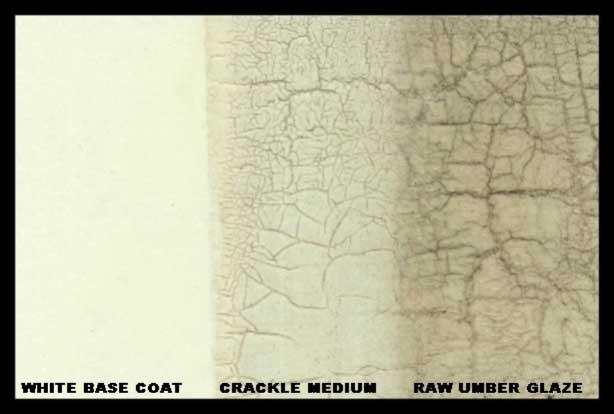Crackle Finish Techniques
Tips, advice and discussion on getting the desired results from a crackle-coat finish. February 19, 2006
Question
Has anyone done crackle finishes? I am doing a light to medium crackle finish over a charcoal vinyl base coat. I have the materials: base color, high gloss, crackle, and eggshell sheen for the topcoat.
Does anyone have any tips for getting the crackle coat on even so I don't have large cracks and small cracks in different places? It seems to be I have best luck with medium dry spray, not to heavy a coat (that makes the crackle large). I want a leathery like texture with 1/4 to 3/4 varied spacing of the cracks. This is my first crackle job. Any help is appreciated.
Forum Responses
(Finishing Forum)
From contributor S:
Consistent crackle can be difficult to achieve. I have found it helps to control the size of the cracks by making sure you apply even coats of both the high gloss and the crackle material. Try not to get more film build in any one area.
Another important tip and key to the secret is "dry time" of the high gloss prior to spraying the crackle over the top. The film needs to be dry to touch but length of dry is important.
Room temperature should be around 70 degrees F. The longer you allow the high gloss to dry, the larger the cracks will be once you apply the crackle material. For smaller cracks apply the crackle quicker over the top of the high gloss. For larger cracks wait longer before applying the crackle material. (Do not scuff sand the high gloss prior to spraying the crackle, you need a slippery surface prep there for the cracks to form, sanding the high gloss will make it difficult for the cracks to develop.)
Usually 15 to 20 minutes will produce medium cracks. Work up a few practice panels and mark them on the back with different dry times and time your project accordingly. I've done crackle finishes for years and those are the only tips I have found that really make a difference.
From contributor T:
Contributor S gave excellent tips. Using Mohawk products I had the best luck producing small patterns by "over-reducing" the crackle medium and spraying thin but wet, sometimes with 2 coats. You face a learning curve here, but it can be fun seeing the varied results when you make your (multiple) sample boards.
From contributor M:
I suggest that you try out the small and large size crackle mediums. These paste mediums can be purchased at many paint stores or arts and craft shops. With some practice, you can get good uniform consistency in the size of the crackle.
From the original questioner:
What do you do if it doesn't turn out well? Can I sand and re-gloss/re-crackle? Can I reactivate the crackle before the top coat is applied?
From contributor M:
You can even try repeating the process on the same piece if it fails. You have more to gain then to lose.
From contributor G:
To contributor M: Are you using lacquer crackle, water bourne crackle (regular crackle), china crackle, or weathered crackle?
From contributor M:
Most crackles mediums are made up from the flattening agent that is used in the coating to reduce their sheens. The size of the crackles will depend on the amount of flattening compound that is added to each medium, and in some cases thinner is added to alter the size of the crackle.
Some of the names you mentioned, which I am familiar with, are just fancy names given by the manufactures for the size of there crackles.
From the original questioner:
The material I'm using is
Sherwin Williams lacquer. I found if I go over a sprayed area again with a heavier coat to get it to crack (first coat too light, didn't crack) that it will crack, but then the white crazing overspray does not all burn back in, and sometimes if it does clear up, it comes back later.
From contributor M:
The blushing may be due to condensation in the shop, equipment, or the material. Heavy coats mean, that you should allow extra time for the slower solvents to exit the coating. Instead of the "charcoal" misting, why don't you glaze the crackle, raw umber works well and there are many other color glazes that will compliment the decor of the furniture. Glazing will add a nice effect to the crackle coatings.

Click here for full size image
From the original questioner:
To contributor M: I would love to be able to glaze it but the color of the project is charcoal (pure) with fairly light crackle. Almost leathery like and the white snow just sticks out like a sore thumb.
By the way the cabinet is large 77 x 58 x 14 with a finished top, which is where the last bit of white snow has reappeared. This didn't happen until I covered the top and end panels so they wouldn't get overspray while I finished the face frame. Guess I left the top covered to long.
From contributor G:
"Most crackles mediums are made up from the flattening agent that is used in the coating to reduce their sheens. The size of the crackles will depend on the amount of flattening compound that is added to each medium, and in some cases thinner is added to alter the size of the crackle. "
Lacquer crackle gives a completely different effect than regular crackle, and it is what I consider a very unrealistic look because of the shrinkage around the edges of the cracks, and uniformity of cracks.
I think you are correct in the different amounts of flattening agent in the difference between regular crackle and china crackle. Weathered crackle has some type of additive, different from flattening agent, which results in a different final look.
